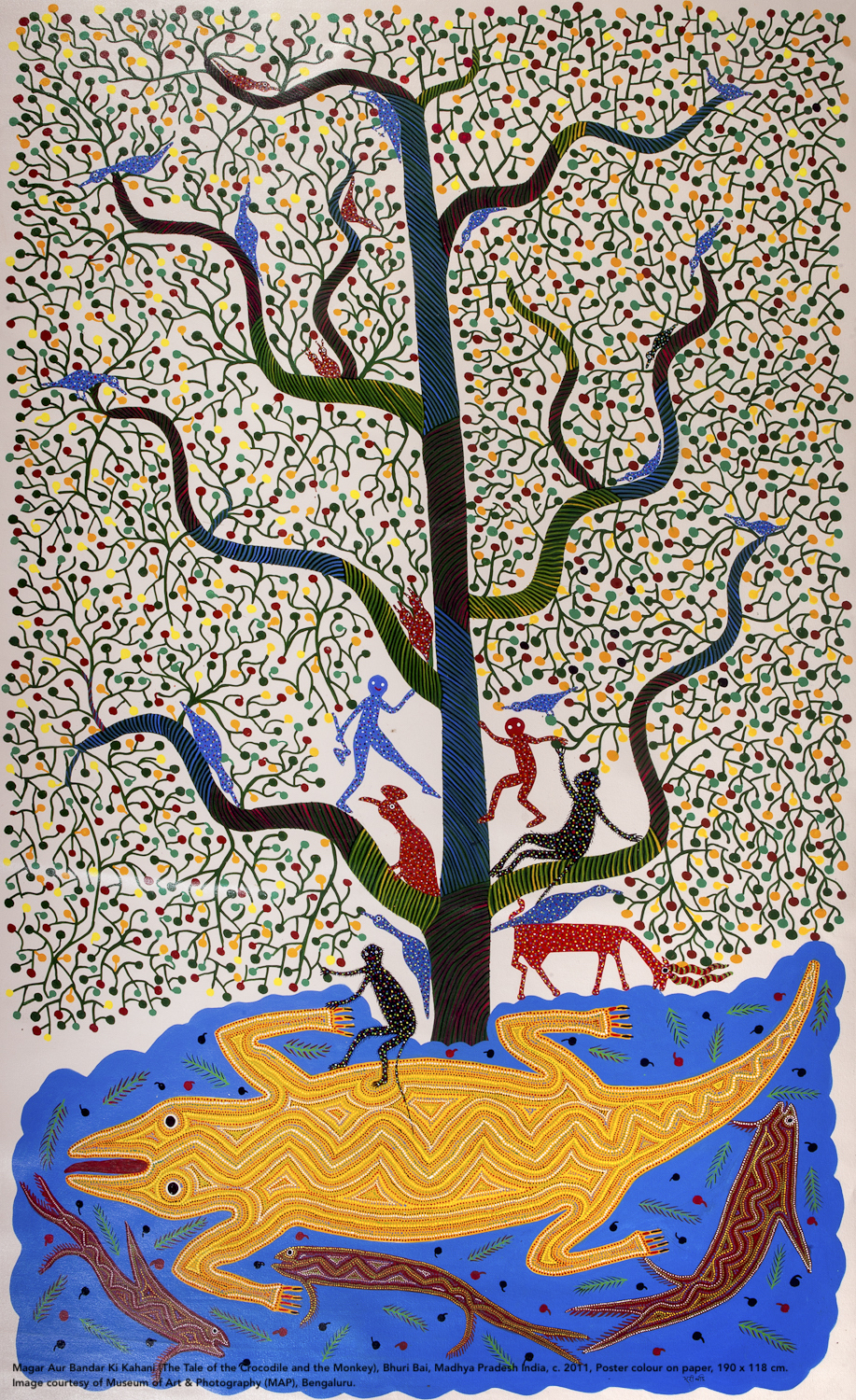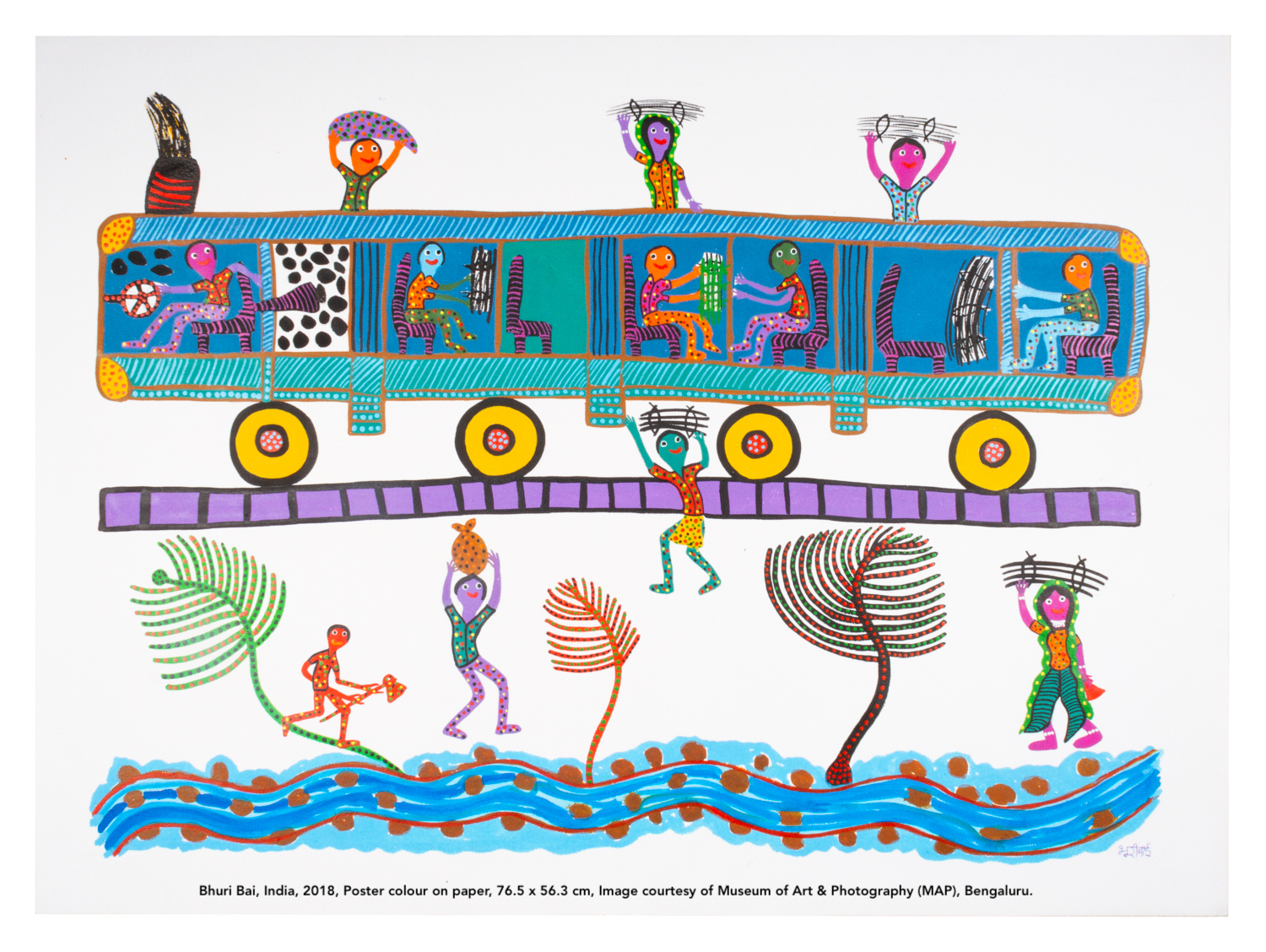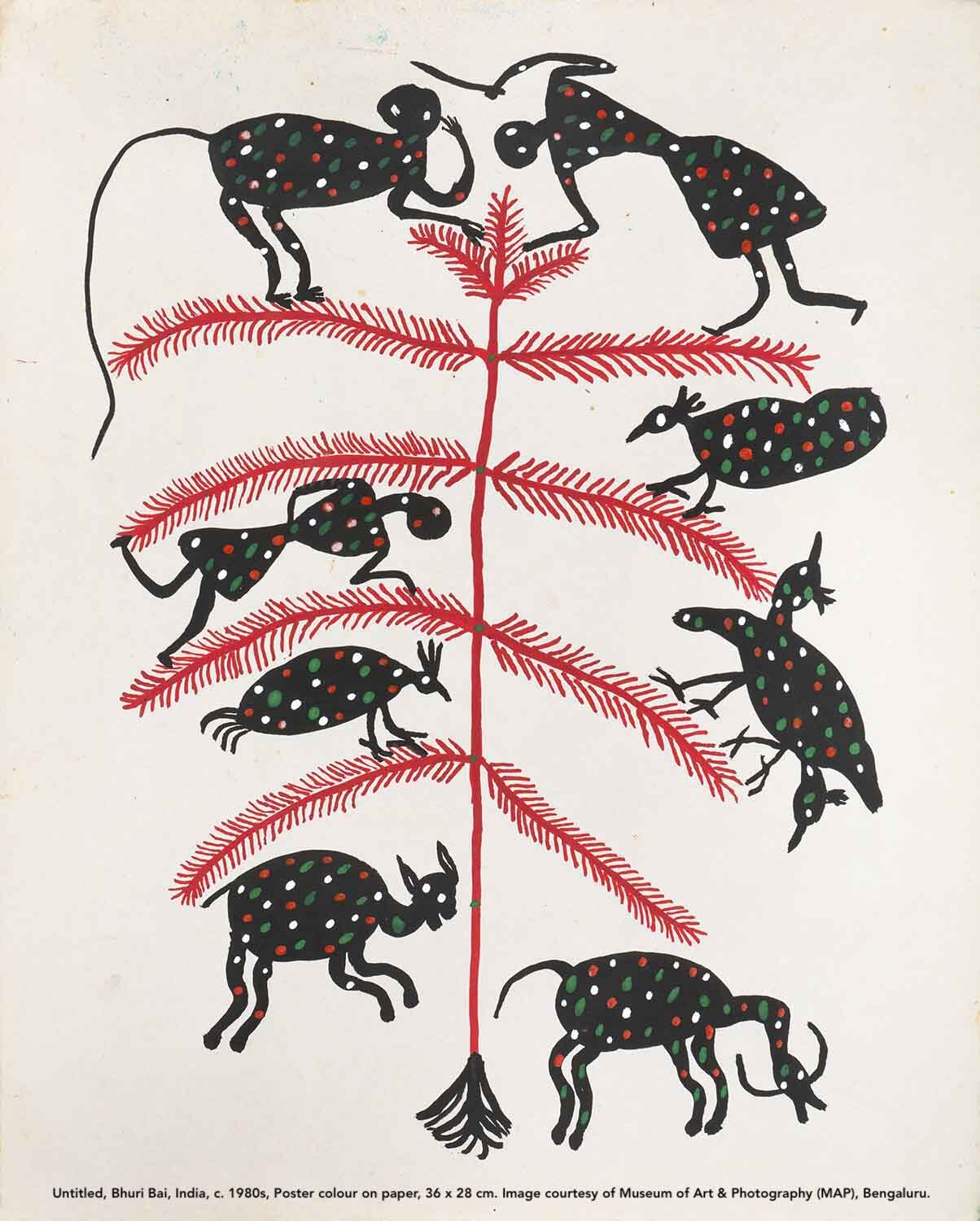Delight in the vibrant art of Bhil artist Bhuri Bai
Editor’s Note: This article was first published on MAP Academy—a wonderful resource of stories on cultural heritage, art, museums and lots more. You can find other wonderful essays on art and culture over at their website. This month, they offer a wonderful and colourful profile of Bhuri Bai–one of India’s great women artists who started out as a day labourer in Madhya Pradesh.
About lead image: Untitled, Bhuri Bai, India, c. 1980, Poster colour on paper, 56 cm x 71 cm. Image courtesy of Museum of Art & Photography (MAP), Bengaluru.
A renowned Bhil artist, Bhuri Bai is the first artist of the community to work with paper and canvas as a medium. Born in Pithol village in Jhabua district, Madhya Pradesh, Bhuri Bai was exposed early to traditions such as the Pithora mural painting rituals. The women of the community were not permitted to participate in these activities. Drawing the central deity, Pithora Dev, and the religious iconography around him, such as horses of the god, was strictly done by the men of the community. Priests would create sacred Pithora paintings with cow dung on the walls of the huts in her village. Bhuri Bai’s interest in this practice led her to begin painting the mud walls of her family home, using locally available natural pigments and twigs wrapped in cotton or rags, to depict a range of subjects, including those seen in Pithora painting.

After getting married at the age of sixteen, Bhuri Bai moved to Bhopal with her husband, Johar Singh, at the age of twenty, where both husband and wife worked as wage labourers in construction. She was working on the site of Bharat Bhawan when its then-director J Swaminathan was scouting for artists and painters from among the workers there. On Swaminathan’s insistence, Bhuri Bai began making paintings for him, which marked her transition from painting on mud walls to using art supplies such as poster paints, brushes and packing paper that were provided to her.
With these new materials, she could not only practise painting on a smoother surface, she was also able to experiment with more colours, a broader range of subjects that referenced her life in the village, as well as various perspectives and forms, thus going on to develop a unique style of experimental and figurative painting, borrowing from elements of Pithora paintings as well as her own visual language.
 Bhuri Bai’s subject of choice was the life of the Bhil community, particularly her childhood memories of Pithol. Her work incorporates songs, rituals, tattoos, folklore, flora and fauna, festivities, dances and village architecture like hutments and granaries. She also integrated diverse palettes and schemes alongside the traditional visual grammar of Pithora painting, such as elongated animal and human forms, elaborate patterns, stippled dots and coiling motifs.
Bhuri Bai’s subject of choice was the life of the Bhil community, particularly her childhood memories of Pithol. Her work incorporates songs, rituals, tattoos, folklore, flora and fauna, festivities, dances and village architecture like hutments and granaries. She also integrated diverse palettes and schemes alongside the traditional visual grammar of Pithora painting, such as elongated animal and human forms, elaborate patterns, stippled dots and coiling motifs.
 As her career took her to more cities in India and abroad, she started painting scenes that included motifs and elements from contemporary urban and industrial society such as buses, cars, aeroplanes and televisions. Today, Bhuri Bai’s style and subject are a culmination of her cultural influences and personal experiences as well as her many experiments with form. She typically does not paint with the conventional vanishing point perspective of Western art, instead implying three-dimensional space solely through strategic vertical and horizontal placement, regardless of proportions.
As her career took her to more cities in India and abroad, she started painting scenes that included motifs and elements from contemporary urban and industrial society such as buses, cars, aeroplanes and televisions. Today, Bhuri Bai’s style and subject are a culmination of her cultural influences and personal experiences as well as her many experiments with form. She typically does not paint with the conventional vanishing point perspective of Western art, instead implying three-dimensional space solely through strategic vertical and horizontal placement, regardless of proportions.
 Among her most renowned works are her murals on the 70-feet high wall at the Madhya Pradesh State Tribal Museum, where she narrates the story of her own life. She is also trained in hut-building, a practice she learnt from her mother Jhabbu Bai. She was also involved in the construction of the Bhil hut in the Indira Gandhi Rashtriya Manav Sangrahalaya, Bhopal. Together with Lado Bai, she worked on a few paintings which were photographed by Jyoti Bhatt in 1983 and later published in Jagdish Swaminathan’s book ‘The Perceiving Fingers’ (1987).
Among her most renowned works are her murals on the 70-feet high wall at the Madhya Pradesh State Tribal Museum, where she narrates the story of her own life. She is also trained in hut-building, a practice she learnt from her mother Jhabbu Bai. She was also involved in the construction of the Bhil hut in the Indira Gandhi Rashtriya Manav Sangrahalaya, Bhopal. Together with Lado Bai, she worked on a few paintings which were photographed by Jyoti Bhatt in 1983 and later published in Jagdish Swaminathan’s book ‘The Perceiving Fingers’ (1987).

Bhuri Bai’s work has been extensively exhibited in museums and galleries within India, as well as Europe, Australia and the United States. She has exhibited with institutions such as the Culture Ministry of India; the National Crafts Museum & Hastkala Academy, New Delhi; Pundole’s Gallery, Mumbai; Centre of International Modern Art (CIMA), Kolkata; Musée du Quai Branly, Paris; and Maison Guerlain, Paris.
Her work has been showcased at landmark exhibitions such as Now That the Trees Have Spoken at Pundole’s Gallery in 2009; Other Masters of India at Musée du Quai Branly, curated by Jyotindra Jain and Jean-Pierre Mohen (2010); and the second iteration of Vernacular in the Contemporary curated by Jackfruit Research and Design led by Annapurna Garimella (2010). A comprehensive virtual exhibition of her work, Bhuri Bai: My Life as an Artist, was organised by the Museum of Art and Photography, Bengaluru in 2020.
 In 1986, the Government of Madhya Pradesh awarded her with the Shikhar Samman, followed by the Devi Ahilya Samman in 1998 the Rani Durgavati Award in 2009. In 1999, she accompanied Pardhan artist Jangarh Singh Shyam in a presidential delegation to an art workshop in Australia organised with aboriginal artists such as Kathy and Djambawa Marawili.
In 1986, the Government of Madhya Pradesh awarded her with the Shikhar Samman, followed by the Devi Ahilya Samman in 1998 the Rani Durgavati Award in 2009. In 1999, she accompanied Pardhan artist Jangarh Singh Shyam in a presidential delegation to an art workshop in Australia organised with aboriginal artists such as Kathy and Djambawa Marawili.

Her recognitions led to her appointment as resident artist at the Adivasi Lok Kala Academy, Madhya Pradesh in 2002. In addition to rendering Pithora paintings on paper, canvas, wood, mud pots and textiles, she has also illustrated books such as Bhili Kathayein (2005) and Bhil Janjateeya Geet (2006). She was awarded the Padma Shri by the government of India in 2021.
At the time of writing, Bhuri Bai lives and works in Bhopal, where she is resident artist at the Madhya Pradesh Tribal Museum.

The MAP of Knowledge
The MAP Academy encourages knowledge building and engagement with the visual arts of South Asia through its free and fully accessible offerings—Encyclopedia of Art, Online Courses, and Stories. If you liked this story, you might be interested in Textiles from the Indian Subcontinent—a first-of-its-kind online short course developed by the MAP Academy exploring the histories of South Asian textiles. It provides insights into the processes of cloth production and aims to create awareness and appreciation of age-old textile traditions, examining their global impact on culture, fashion, and sustainability. This course is free, self-paced and offers learners a Certificate of Completion. To explore new and interesting stories from South Asia’s art histories, follow us on Instagram.


 souk picks
souk picks